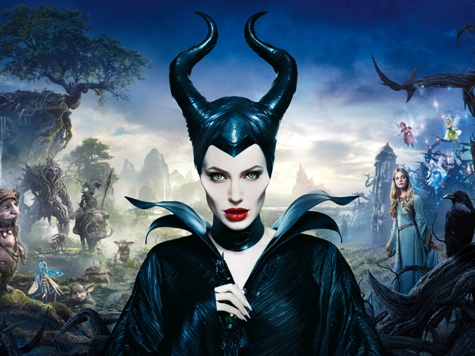Walt Disney’s latest big-screen fairy tale “Maleficent” has two things going for it, and those are enough. The first is a lean run-time of 97 minutes (closer to 90 without end credits). The second, a commanding star turn from Oscar-winner Angelina Jolie, whose less-is-more approach should serve as a tutorial in exactly how to be a modern-day movie star.
Both of these factors save this cinematic twist on “Sleeping Beauty” from being just another one of Disney’s profitable but soul-killing live-action fantasy films. All things being the same, at 120 minutes, the review below would read much different.

In her original incarnation, the character of Maleficent, The Mistress of All Evil, curses baby Princess Aurora (Sleeping Beauty) to prick her finger on a spinning wheel needle before her 16th birthday and fall into a death-like sleep. Only a kiss from a true love will awaken her. In Disney’s 1959 animated classic, Maleficent is driven by equal parts evil and a very thin skin.
Director Robert Stromberg uses the first thirty minutes of “Maleficent,” his debut feature, to showcase the betrayals and disappointments that embittered Maleficent into someone who would curse an innocent infant. From here, we and Maleficent watch Aurora grow to be 16 (Elle Fanning) as her father, the King (Sharlto Copely), plots a way to kill the sorceress who cursed his daughter.
“Maleficent” a $200 million production, is packed with fairies and trolls, dragons and tree monsters, meticulous production design and a whole lot more of that hollow precious fantasy stuff that never fails to leave me cold. The film’s best asset, by far, is Jolie, who is in almost every scene and mesmerizing to watch.
It’s not hard to imagine Jolie’s Maleficent joining Lugosi’s Dracula, Karloff’s Frankenstein, or Anthony Hopkin’s Hannibal Lectre as a career-defining and iconic cinematic character.
What makes Jolie’s performance so memorable is her restraint. She has a couple of Big Scenes, but one of the reasons those scenes work as well as they do is Jolie’s otherwise controlled performance. I’ve read how while filming his breakthrough role in “Bullitt” (1968), Steve McQueen went through the script crossing out line after line of his own dialogue.
McQueen understood the power of his own screen presence and that the less he said the more the audience couldn’t take their eyes off of him. Jolie uses the same blueprint. Rather than do what most actors would in such a role, chew the scenery, she uses the deceptive power of understatement and stillness to command the screen and to make everything she does do (a look, smile, wave of her hand) all the more potent.

Forty years ago Jolie’s considerable star power was a given, expected, the norm. Today, she’s an endangered species, one of about five of her kind, and that makes “Maleficent” an even bigger pleasure.
The story itself is nothing special. There isn’t much plot, which is a relief when you remember how many films in this genre are bloated with complicated storylines and the butt-numbing creation of mythology (I’m looking at you Peter Jackson). “Maleficent” is really about how our relationships with others shape who we are, in ways good and bad.
Because I had no other choice but to attend a 3D screening (I’m not a fan), I can report that the effects look terrific. The boys will love the action. The girls will love the romance, the typical princess wish-fulfillment, and all the cute little creatures that populate every inch of the screen. Overall, there’s nothing too intense for the young ones.
I was never bored but I also wasn’t terribly invested. I just couldn’t take my eyes off of Jolie, and that was enough to make the 90 blessedly brief minutes worthwhile.
Follow John Nolte on Twitter @NolteNC

COMMENTS
Please let us know if you're having issues with commenting.